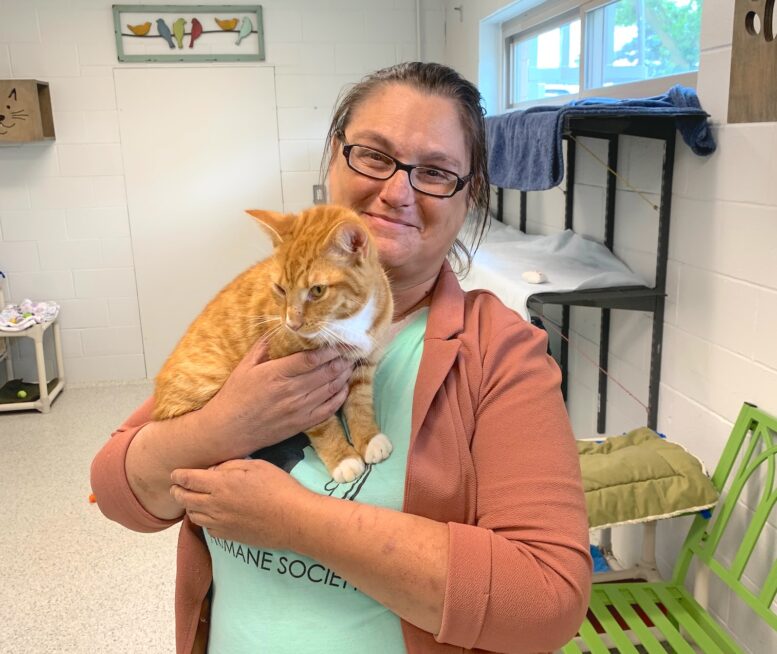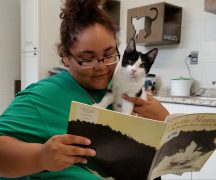By JULIE CARLE
BG Independent News
Megann Smith knows animal shelters can be stressful for animals and the people engaged with the animals.
Her work with the Wood County Humane Society for 10 years, most recently as director of shelter operations, has provided a front-row seat to animal and people behaviors.
She knows cats are as different from one another as people are and that shelter life takes a toll on animals’ adoptability the longer they are in a shelter.
Smith likes to share what she’s learned through experience and research with her team. She also has branched out to present at national conferences on topics such as “Foster Finders,” and “Feeling the Loss of a Pet that Wasn’t Yours: Grieving Loss in Rescue.”
At the Humane Society of the United States national conference in San Antonio in May, Smith shared insights into creating nurturing and stress-free environments for shelter cats and practical strategies for improving experiences for cats in shelters.
Though she considers herself “an every-animal person, I’ve always liked dogs more,” Smith said. “But there is so much information available about dogs that I knew I needed to learn more about cats.”
As she read articles, watched videos and talked to certified cat behaviorists, Smith grew to favor cats more. “I also found that because I understand cats, I understand dogs more now,” she said.
Her talks included tips that were less about reinventing the wheel and more about finding and sharing those little quirks that can make a difference in the shelter and care of the animals. Focused on enrichment and behavior training, Smith believes in keeping the activities cost-effective because most shelters are nonprofit organizations, she said.
“The key is to set up each animal for success when they step into the building on Day 1,” she said.
Creating a stress-free-as-possible environment is important from the beginning. Cats have a few specific needs in their space. Because incoming cats usually start in isolation kennels, they need a perch, a hiding spot, and separate food and water areas, Smith said.
Hiding spots can be as simple as cardboard boxes, litter box lids or paper bags.
She cited a study of 60 cats that found when cats were not offered a hiding spot, they spent 45 percent of their decompression time in their litter box. Those cats also exhibited a higher level of stress.
Smith also recommended the importance of understanding a cat’s body language. “It is more than hissing and a poofy tail,” she said. They may tense up, back away or flatten their whiskers against their face to indicate an unhappy or stressful mood.
“Knowing a cat’s body language helps you establish and understand a cat’s boundaries. Once the cat knows you respect its boundaries, it will welcome you,” she explained.
Fight, flight, freeze, fidget
“Cats, which are predator and prey animals, live in a very distinct bubble,” Smith said. As a predator, they are confident and happy, but when they are out of their territory or routine, such as in a shelter, instinctively they resort to their prey space.
“That’s when you see reactive behaviors such as fight, flight, freeze and fidget,” she said. Fight and flight responses are familiar because they are common responses for humans.
Freeze is when cats are so overcome with fear and stress they become statue-like. “Their brains tell them if they don’t move they can’t be seen and they will be safe,” Smith said.
Cats in fidget mode constantly move because they don’t know how to expel excess energy.
Smith said the best way to navigate those different responses or mitigate the behaviors before they arrive is through the assessment process, medical intake, and integrating the cat into a free-roam room.
The idea is “to set them up for success,” though she admitted what works for one cat doesn’t necessarily work for all cats.
Daily enrichment is important for gaining trust and helping the cats feel comfortable in the setting. Do-It-Yourself enrichment can be effective and cost-effective, “because, at a nonprofit, cost is important,” Smith said.
If there are several cats in isolation kennels, see what cats are watching and then “dance for them or read a book like they are a bunch of second graders,” Smith said.
Don’t have a book? A shelter to-do list read with inflection will do the trick.
By minimizing the stress of a cat in a shelter you decrease their length of stay, she explained. “The longer a cat is in the shelter, the more susceptible they are to illness, their behaviors decline, and they age. All those things gradually decrease their adoptability to people wanting to take them home. That’s the sad reality,” Smith said.
Another presentation, new topics to share
During the June 8 virtual National Kitten Coalition, Smith will discuss two initiatives that are part of the humane society’s protocols for dealing with grief experienced by those who care for animals in need and finding fosters.
As a certified pet loss bereavement specialist, Smith helps volunteers, team members, fosters and families deal with the loss of pets. The loss might be “that injured stray that you had to help pass even though you only knew it for 20 minutes,” she said. Grief might also be when a long-stay shelter animal is adopted or a foster animal goes back to the shelter.
At the shelter level, team members and volunteers often forget to take a moment for themselves because of the volume of animals that come in and go out. “They get embarrassed because it is just part of the job,” Smith said. “But it’s okay to grieve because grief is part of humanity and compassion.”
Grief extends to the families who have to surrender their pets, she said. “They are losing that family member. Sometimes that’s a hard concept to understand, but we don’t know the circumstances behind that decision.”
In the shelter training, she stresses that everyone who is reaching out to the humane society, regardless of what they say, has the same wish as the shelter staff, “to do what’s best for the animal,” Smith said.
She also will address the Foster Finders initiative at the shelter. The program focuses on asking community members to foster kittens they find, Smith explained.
The concept has been used informally in recent years, but as the need for pets to come to shelter has “drastically increased,” Smith has been implementing Foster Finders more often.
Uncertain why there is an increase, Smith believes it may be tied to “societal and economical changes going on.”
When the shelter was closed for quarantine last year, they were able to help more than 30 cats through Foster Finder.
“We have an honest conversation with people who typically have had the cat or kitten in their care for a few days,” Smith said. “We understand they don’t want it to be forever.” However, the shelter offers guidance and to help with food, and medical supplies “if they would be willing to keep them a little longer.”
“It’s a natural piece of the puzzle because people who find the animals truly care about them. Even if they foster just one time, it helps the situation,” she said.
Smith hopes to continue educating others about animal care in shelter settings. She already has proposals submitted to present at future conferences.
“We are thrilled to see Megann recognized for her expertise and commitment to animal welfare,” said Liz Gordon, vice president of the Wood County Humane Society Board of Directors. “Her dedication to improving the lives of animals in Wood County is truly inspiring, and we are proud to have her represent our organization on such significant platforms.”





